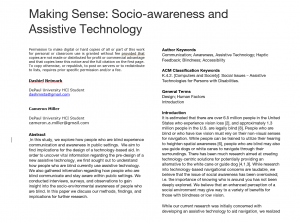
Project Background
This is an academic research project that was carried out during my time at DePaul University. This project showcases three common research methods: interviews, surveys, and direct observation. Although the paper is brief, the project yielded interesting findings that could warrant further research in the fields of assistive and spatial technology.
Abstract
In this study, we explore how people who are blind experience communication and awareness in public settings. We aim to find implications for the design of a technology-based aid. In order to uncover vital information regarding the pre-design of a new assistive technology, we first sought out to understand how people who are blind currently use assistive technology. We also gathered information regarding how people who are blind communicate and stay aware within public settings. We conducted interviews, surveys, and observations to gain insight into the socio-environmental awareness of people who are blind. In this paper we discuss our methods, findings, and implications for further research.
Methods
Participants
We recruited 12 people with low vision or blindness through contacting organizations for the blind, social networking, and the “snowball” method.
Procedures: Interviews
We interviewed our participants over the phone and through email. [CP4] The phone interviews were audio recorded. Our interview questions were based on awareness and communication and were organized in a conversational manner. The first section of the interview contained questions regarding communication, such as, where live communication usually takes place, how often live communication occurs, and whether or not assistive technology is used to assist in these processes. The second section of the interview contained questions regarding awareness, such as, how our participants sense when people are in close proximity, what methods people use to know when another person enters a room, whether engaging activities such as listening to music or books affects awareness, and if assistive technology is used to assist in these processes.
After the interviews were transcribed, we inductively coded the interviews for common and salient themes using the Saturate web application. We then grouped the codes in order to construct categories. We utilized the information gathered from the interviews to guide the development of survey questions.
Procedures: Surveys
We constructed an eighteen-question survey. The survey was broken up into three sections. The first section contained questions regarding communication, such as, how often verbal communication occurs within their home, how frequently technologically-aided communication occurs, tendency and methods for initiating conversations, and satisfaction of current methods of initiating conversation. The second section contained questions regarding social awareness, such as, methods for discovering other individuals within the same room, feelings towards being in close proximity to strangers, and how current use of AT affects socio-environmental awareness. Lastly, we collected demographic information about each participant, such as level of vision impairment, types of assistive technology used, satisfaction of those devices, mobile operating system, age, employment status, and length of assistive technology use. The survey was administered through Google Forms and was sent to participants via email. We took advantage of Google’s built in survey response summary in order to gain further insight into our responses.
Procedures: Direct Observation
Three direct observations were performed, each lasting between 20-30 minutes. We observed how people with low vision navigate through a coffee shop. The participants were simply asked to follow their normal routine in ordering and consuming their beverage. We used the AEIOU framework to track and record our observations. We then collaboratively sorted our comments into homogenous groups via the Stormboard web application.
Results
Interviews
We interviewed a total of three people. After qualitatively analyzing the data, we discovered four overarching themes.
Finding #1: Awkward Silence
It was strongly preferred to avoid silence when in close proximity to a stranger. Individuals with low vision would much rather the stranger either initiate a conversation or remove themselves from the general area. Our participants reported that an uncertainty of who is in close proximity, coupled with silence, makes for an uncomfortable situation.
Finding #2: Enhanced non-visual awareness
Interviewees explained their methods of sensing others in their environment. This overarching theme emerged due to the variety of methods that our interviewees described to be useful. It was common that our participants utilized the sound of environmental features to stay aware of their surroundings such as verbal communication of others, automobiles, doors, foot steps on a hardwood floor, or the sound of pets reacting to visitors. However, sound was not the only method of staying aware. Our participants noted that they can smell certain people or feel their body heat when they are in close proximity. One participant in particular (P2), noted that she can feel the “vibe” of a person in close proximity, even if she cannot hear them. She said “It’s like that feeling you get when you just know someone is behind you, you can just feel that person…it is like that on all sides.”
Finding #3: Difficult to approach
All interviewees mentioned that they felt that the reason many sighted individuals hesitate to initiate a conversation with them is due to a lack of commonality which to base a conversation.
Finding #4: Strong inclination towards information and communications technology (ICT)
Unanimously, interviewees claimed to frequently use texting, e-mail, social networks such as Facebook, Twitter and other ICTs.. It was also noted that it may be useful if future assistive technologies incorporated social media to some extent.
Surveys
We received a total of six survey results. Admittedly, this is a low number of participants – but we feel that we were still able to some gain valuable insight from the responses. We pulled two main findings from our surveys.
Finding #5: Feelings towards being in the same room as a stranger
Fifty percent of participants mentioned a feeling of indifference towards being in the same room as a stranger, as long as they know that they are there. The other fifty percent described themselves to feel guarded, nervous, and overwhelmed when they do not know who is in close proximity to them.
Finding #6: Current and preferred socio-awareness detection methods
All survey participants stated that they currently form a mental map of who is around them via noise / speech. It was found that five of six participants rely on hearing alone to know who is occupying the same room as them. Furthermore, four of six participants noted that their current use of assistive technology does not help increase their awareness of people in their environment
Direct Observations
We identified two cardinal findings based on our observational data.
Finding #7: Possible difficulty socializing
In most cases, after placing the order, the participant was somehow instructed or prompted by the barista that their drink will be available at X side of the counter. This task-driven process looked to be quite simple for our participants to complete. However, non-task oriented interactions, such as acknowledging or socializing with others seemed scarce compared to our own expectations. Further research into the implications of this finding may be warranted as our expectations for how socialization should occur in this type of public space may be biased.
Finding #8: Tight-knit movement challenges
From standing in line and moving in small increments towards the cashier, to moving towards the area designated for picking up your drink, all three participants seemed to exhibited challenges in tight-knit movement. It was noted that the participants appeared to mostly respond to the cashier’s speech – “Next” or “How may I help you?” – to determine whether or not the line was moving. This phenomenon seemed to be dependent on the amount of people in line at the shop. . There were two instances where people in line informed the participant when it was time to move in line, but this type of instruction was not made available in one instance.
Discussion
Despite a relatively small sample size of 12 participants, we believe our research serves as a valuable stepping-stone for future research. We collected rich data through a variety of mediums. We were able to use this data to construct thematic conclusions that warrant further research into this field of study. In the future, we would like to expand on these research topics with a larger sample size.
Theme #1: Interaction type
Drawing upon the data in findings #1 & #5, we believe that the sometimes-troublesome process of socializing with strangers in a public atmosphere stems from two issues. The first issue is that blind-to-sighted first-time interactions sometimes lack a non-task driven common ground (as mentioned by all interviewees in finding #3). We make this distinction between task driven interactions and non-task driven interactions because the former (such as in finding #8, where other people standing in line at the coffee shop would inform the participant when it was time to move forward) may stem from a feeling of obligation rather than desire.
Theme #2: Lack of visual social cues and the social gap
Natural, free-flowing social interaction is quite different than the aforementioned task driven interactions. For example, sighted individuals may initiate a conversation with strangers based on environmental surroundings. People with low vision lack the ability to leverage visual environmental aspects as a utility to socially connect with others. The interviewees mentioned on several occasions that, if the stranger at least knew their first name and could address them directly, this social barrier might be different. As finding #7 suggests, the second issue in initiating a social interaction is the inability to pick up on non-verbal cues, such as making eye contact or waving your hand – this was an issue we observed during all three direct observations. Our findings shed light upon the social gap between the people who are sighted and people with low vision.
Finding #2 describes the various adaptations that occur in order to compensate for a visual impairment). Rather than focusing on a limitation-based design solution, we believe that the extraordinary adaptations of people with low vision warrant an ability-based design methodology. We believe that the findings of our study warrant future research within this subject. Furthermore, we postulate that the data gathered in this study highlights potential room for technological innovation, specifically, an ICT-based socio-environmental awareness solution.
Using design to connect people, product, and business

Follow Me
Email: dash@alum.northwestern.edu
Phone: +1 312 478 7147